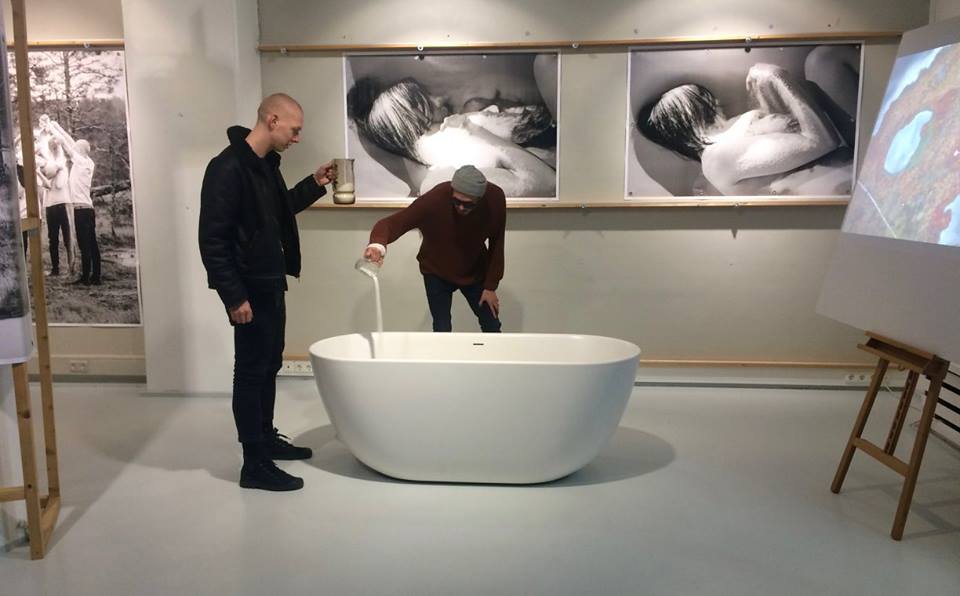This time, the gallery night of Tallinn Tuesdays, which took place on 28 March, had an especially closely connection to music since it was a part of the art program of Tallinn Music Week. The symbiosis between different fields of art and culture is becoming more of a tradition, and so the music festival has joined forces with the developers of modern art by bringing visual arts closer to music friends and vice versa. Art is also being brought closer to the audience in a practical sense – the format of gallery night allows one to take a tour right after the end of the work day, and to go to many galleries at once with an optimal route, which remain open longer than usual that night.
The exhibition program of gallery night included the projects, group and personal exhibitions of Estonian and international artists. When one exhibition was closed within the framework of the programme at Haus Gallery, then the next one was already opened at Okapi Gallery, and in both cases, the artists were giving explanations, one in human language and other in body language. At Estonian Academy of Arts Gallery and at Temnikova & Kasela Gallery, the explanations about group exhibitions were given by gallerists, and at the last staging point, i.e. the Vaal Gallery, no one was explaining anything anymore, if not to consider the remarkable power of explanation of music and noise instruments.
Even though the basis of file curation and reading were not officially published, it seemed that the places were connected, either deliberately or accidentally, by a socio-political spine, a need to say something in social topics. The program started with the ambiguous national romantic exhibition of Mall Nukke “TriColorGames”, where it became clear that a much deeper meaning can be hidden behind technically perfect and beautiful paintings, which amongst everything else touches the painful memory of history and humane topics. This was seconded by Mexican artist Niña Yhared’s exhibition introducing the project “Via Baltic”, in which the artist residing in Vilnius examines the Baltic Way and questions about ethnicity, migration, freedom and borders.
The artist opened the particular exhibition with an interactive performance, in the framework of which she sat in the bathtub naked, covered by only hair and a lily, curled up as she let the audience cover her with sugar. It could have been possible to keep watching the artist, who had slowly started to move herself in the sugar in the background of electronic live music and video projection, if the time to go to the other destination had not come - to the exhibition of USA artist duo OGH (Paige Früchtnicht and Greg Ponchak) “Zones of Indistinction”. The minimalist exposition, coded with cyphers, exposed the artists’ attempt to live in a way, which would correspond to the set procedure, but at the same time would be free of them, in a way in which the only rule would be to ignore rules.
If one part of this paradoxical exhibition was the network almost imitating prison bars, which closed entrances from one exhibition hall to another, then the next staging point talked about cityscape, and the walls were covered by a sonic installation reminding of the public transportation map, made of aluminium, bronze and ribbons. The keyword of the international group exhibition curated by Oleg Frolov “Euroland”, was the participating artists’ interest in the relation between society and physical room and their interpretation, it was possible to see Tõnis Vint’s utopian-urban graphics from decades ago as well as the video works of the representative of younger generation, Leopold Kessler, about the picnic of the dogs in the midst of the “first Tallinn”.
There was not a lot of talking in the fifth and final gallery, as mentioned above. Instead of that, Kristiina and Lauri Sillak were making music, with the first presenting Bach on the violin and the latter interrupting her with handy tools – exactly how the random elements of pop art interrupt the grandiose baroque portraits of Laurentsius. The question about the artist’s critics towards bourgeoisie definitely deserved more attention, but in this case, if four intense hours spent in four different galleries is behind us, the visitor has the complete right to just enjoy the beautiful music as well as the chocolate truffles spiced with chili served at the gallery.
.png)
